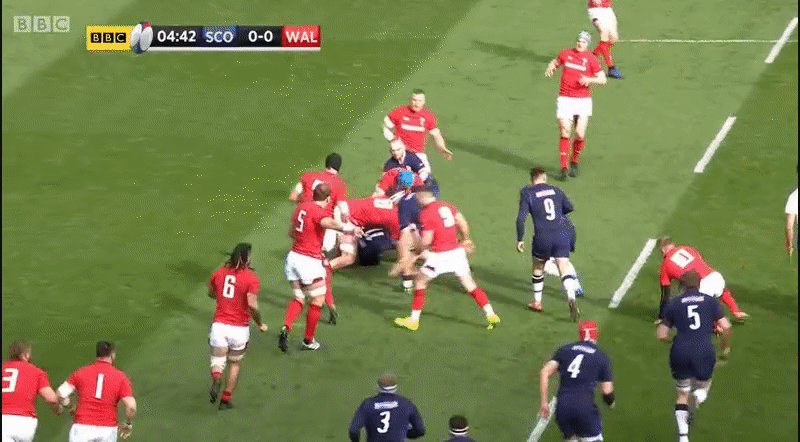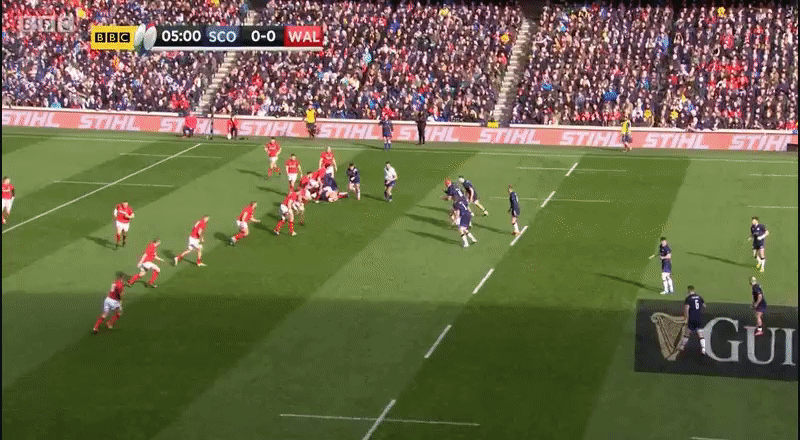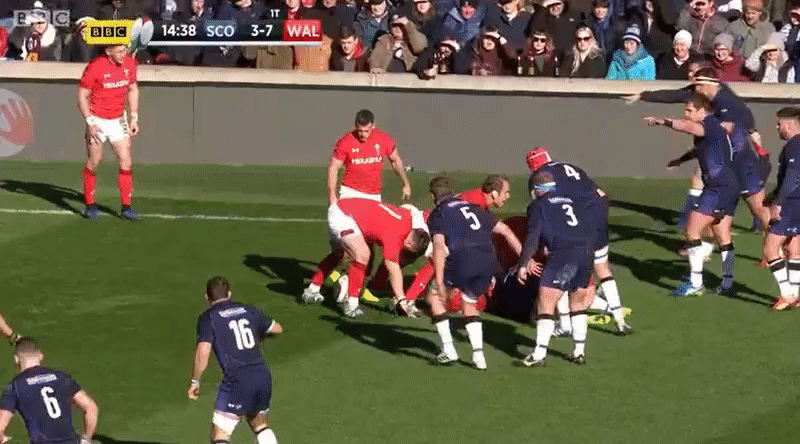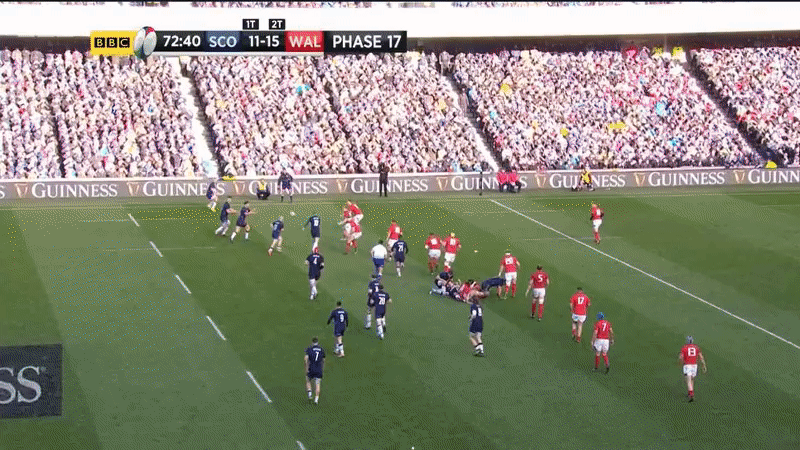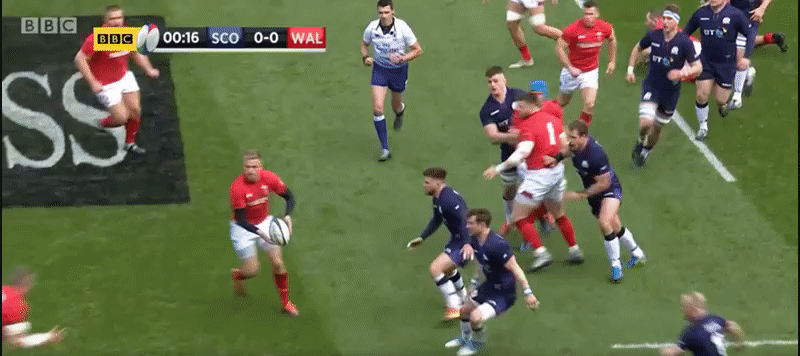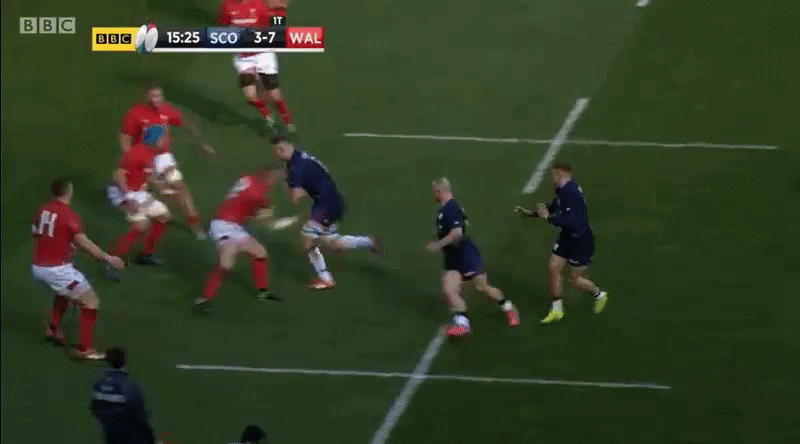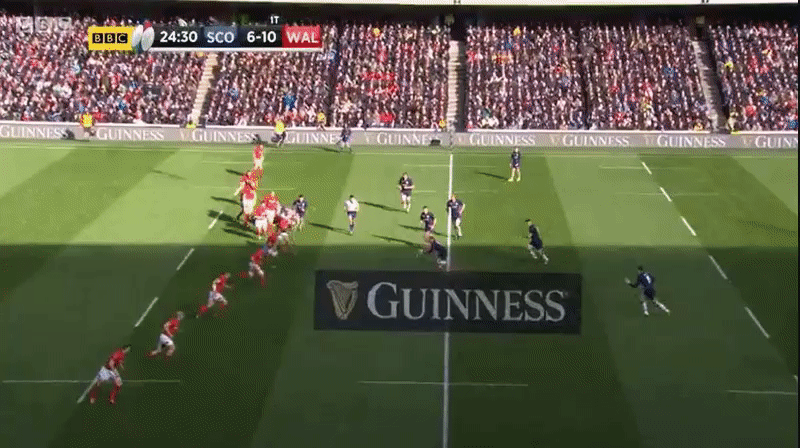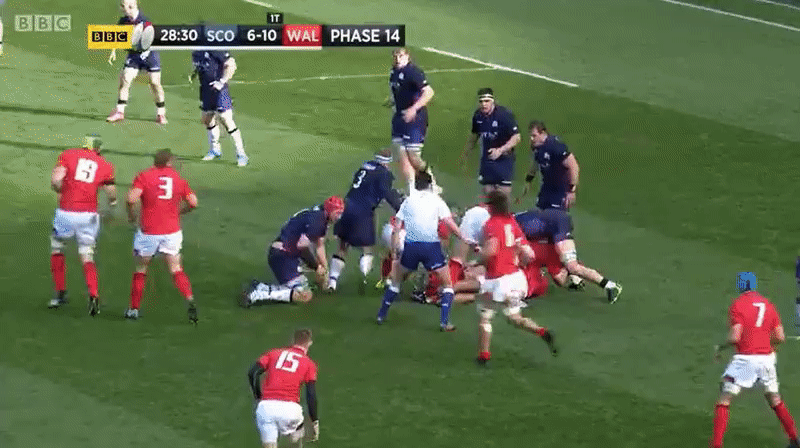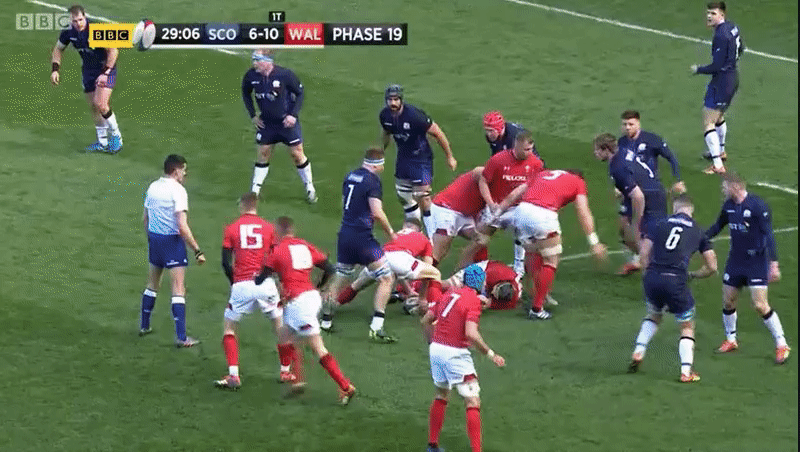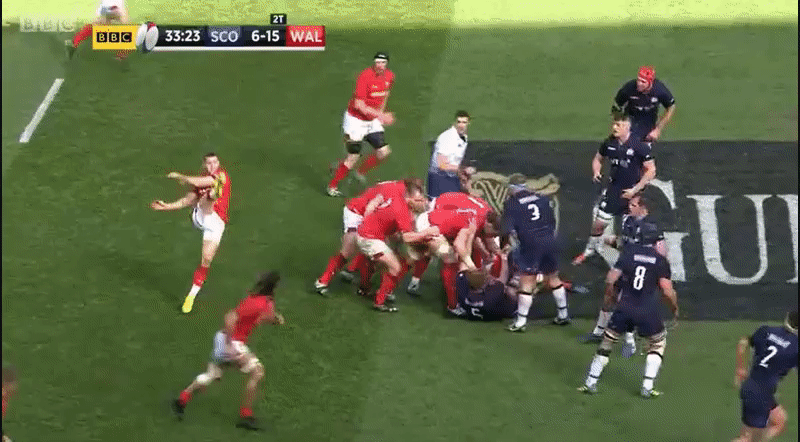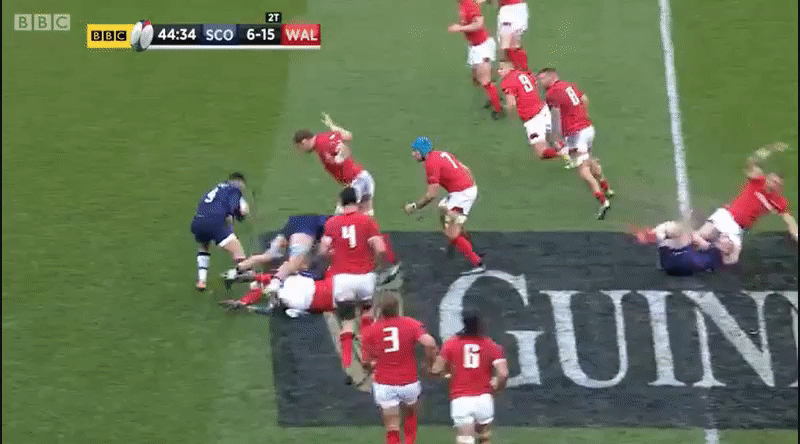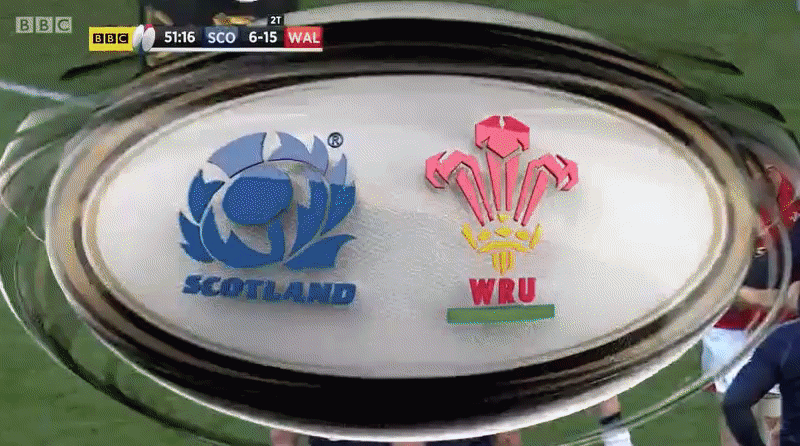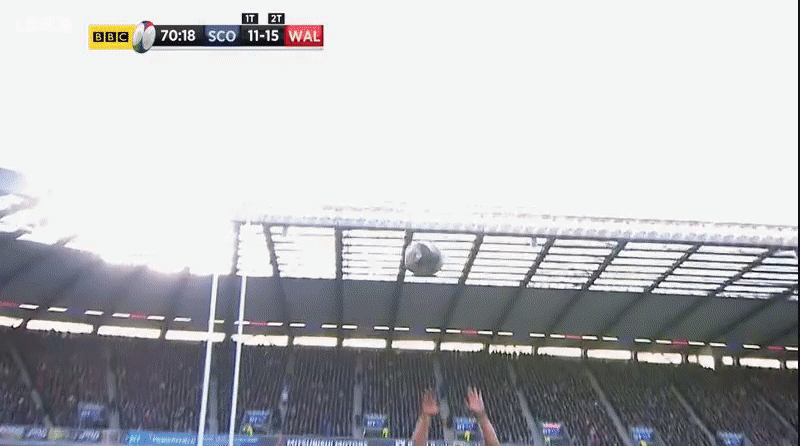Wales’ Grand Slam chances roll on following the victory over Scotland at Murrayfield. A lot was made on how Warren Gatland’s men attacked England in the previous game, but round four was firmly based around their defence. Welsh defence settling platform for victory isn’t a fresh moniker, but Robert Rees takes a look at just how vital it was.
Breakdown pressure
Wales’ back row have been causing the opposition trouble throughout this campaign, but talking a look at how Wales work at the breakdown reveals just how well it comes together.
Wales haven’t committed many men to rucks throughout the tournament, but they have disrupted well with the numbers they did apply. Here initial slow ball from the ruck is fed through to the next phase where Alun Wyn Jones makes the hit and Josh Navidi gets over the ball to give Scotland back foot ball.
This left Scotland with fewer ball carriers on their feet and so Wales could reset easier. This was then backed up a few phases later when Navidi and Jones made the tackle and Rob Evans swooped in for the turnover.
Note how Jones takes out Josh Strauss so Scotland have no support man to secure the ball.
Wales can do this not only because of the skill level of the players involved but because of their line speed. Justin Tipuric shoots out of the line to prevent it going wide. Forcing the ball back towards Ross Moriarty, who tackles before Ken Owens latches on.
It’s a simple two-man job at the collision area, but made by the line speed.
It’s not just in defence that Wales work the breakdown to perfection. When the ball carrier is tackled the support immediately clears out leaving an easy delivery for the scrum half.
Tipuric ensures there’s an immediate clearout with Navidi coming behind in case of a poaching back row player. Wales therefore have front foot ball and this leads to the first try. All without over-committing.
 One thing Wales must work on at the breakdown is applying pillars to the ruck. Tipuric was missing during the England game and allowed Tom Curry to score a try and Davies has been under pressure on the box kicks.
One thing Wales must work on at the breakdown is applying pillars to the ruck. Tipuric was missing during the England game and allowed Tom Curry to score a try and Davies has been under pressure on the box kicks.
Gilchrist charges this one down and Wales get lucky that the laws gave Scotland no clear advantage. Having a three-man chain to ensure a long ruck has become the norm and Wales need to deliver this.
Wales have done well over the ball, but really punished a Scotland side who lack that world class flanker to ward off the opposition. Navidi makes the tackle, but with no immediate supporter Adam Beard can get over the ball, gain the turnover and Wales cleared their lines.
Scotland were wasteful when they entered Welsh territory. Going over 15 phases several times, but taking zero points from the play.
Late on George North wins the turnover, but look at the disruption from Aled Davies to slow Scotland’s ball down and keep it in the ruck.
Parkes stars as Wales continue unbeaten streak
The Scarlets centre left the pitch bloodied and bruised but picked up the Man of the Match award for his efforts. Carrying eight times, often breaking the gain line to set up Wales’ attack (more on this shortly). He also made 14 crucial tackles alongside Jonathan Davies.
Taking just 17 seconds to carry up and over the gain line he helped put Wales on the front foot from the off. It takes two Scottish defenders to tackle him and if there was quicker ball they’d be a man short in the line.
His partnership with Jonathan Davies often pushes him into the shadows when it comes to defensive skills due to the nature of how good Davies is. They work together in a brilliantly cohesive manner, like two, well-oiled cogs.
A great tackle to hold up the ball carrier by Moriarty, Tipuric and Parkes allows the centre to rip the ball and set Wales of in an attack. Having someone who can turn defence into attack this smoothly is going to pay dividends come the World Cup.
There’s a clear game plan from Warren Gatland to hold the ball up. Not only does this allow a chance of ripping the ball (above) it also allows Wales to slow the ball down (below).
That Parkes-Davies combination here, get used to seeing them in this piece. Massively slowing the ball down with a good shot at trying to turn the ball over. Forcing Ali Price to work with slow ball punished Scotland’s attack in the first half.
They were never able to gain any momentum, similar to that of the Wales second half against England.
It was the centre partnership that really turned the game around for Wales. Just like Parkes earlier in the game they gained the turnover in the collision zone.
The double tackle has proved a main feature for Gatland’s men in this year’s tournament and once again it paid dividends forcing a turnover from Blair Kinghorn. It’s this tackling technique that has been crucial for Welsh territory.
Why? Because when the turnover occurs Wales look downfield. Whether it be a territorial kick or carrying over the gain line it creates front foot ball and forces the opponent under pressure.
Building pressure is what Wales is all about. Going through the phases led to Cory Hill’s try against England and a further 23 phases were utilised for Jonathan Davies’ try at Murrayfield. Within this phase of attack Parkes carried twice.
The first of these shows Ball line up as the dummy runner and Parkes taking it over the gain line. Wales build pressure and Gareth Davies gets front foot ball to work with.
You can see above the pre-ruck movement of Parkes to line up in the channel whilst Wales line-up clean ball. He then run straight and hard whilst attaining the ball whilst on the run to crash over the gain line 5 phases later and put Wales in for the final few phases before the try.

Here you can see his movement from the previous ruck and line up for his carry.
His defence gave Wales time. Something that as a defender you crave. His tackle on Darcy Graham under the posts not only stopped a good runner scoring, but the dominant tackle lost Scotland a few metres.
Wales defence – Why is it so good?
- Wales have the ability to not only defend well for 80 minutes, but allow time for the entire line to set.
- The territorial kicking game has been a major facet of the Welsh game plan thus far.
Below shows a box kick being chased down by George North and Gareth Anscombe. Slowing the return run down and allowing Ken Owens and Tomas Francis to make the tackle, slowing it down to prevent a counterattack.
This is why the box kick works when protected.
Taking away momentum and slowing the ball up is something Tipuric does well. Here he holds the ball carrier up, slowing the ball right down and ensuring Wales get set.
You can now see why Gatland wants the tackler to hold the ball carrier up so often. If you watch the defensive line whilst Tipuric holds up Graham they completely reset and align up as trained.
In one of Scotland’s more pressing attacks, Gilchrist crashed up and attempted to get over the line. Parkes, Biggar and Francis ensure he’s held up long enough for the Exeter prop to roll him on his back and force a five-metre scrum.
The Welsh lineout has failed when it’s their ball, but Scotland had six second half lineouts, five of which they could do nothing with. Here Wales wait for the ball to come down before engaging with a huge defensive shove.
Back foot ball again for Scotland who couldn’t get any meaningful delivery from it.


